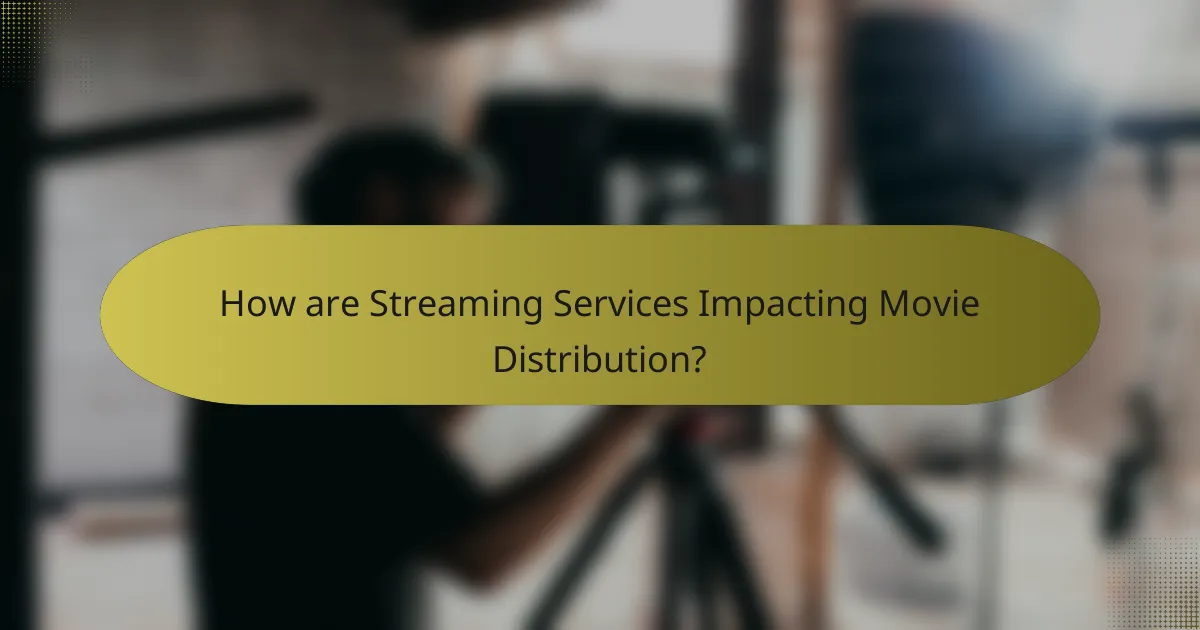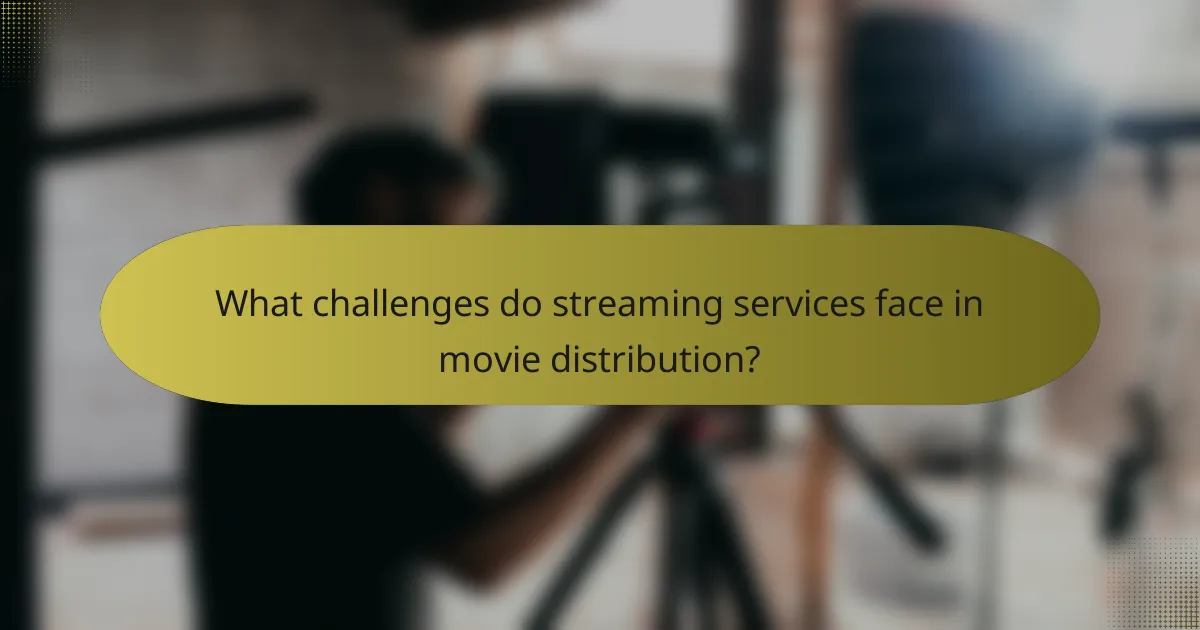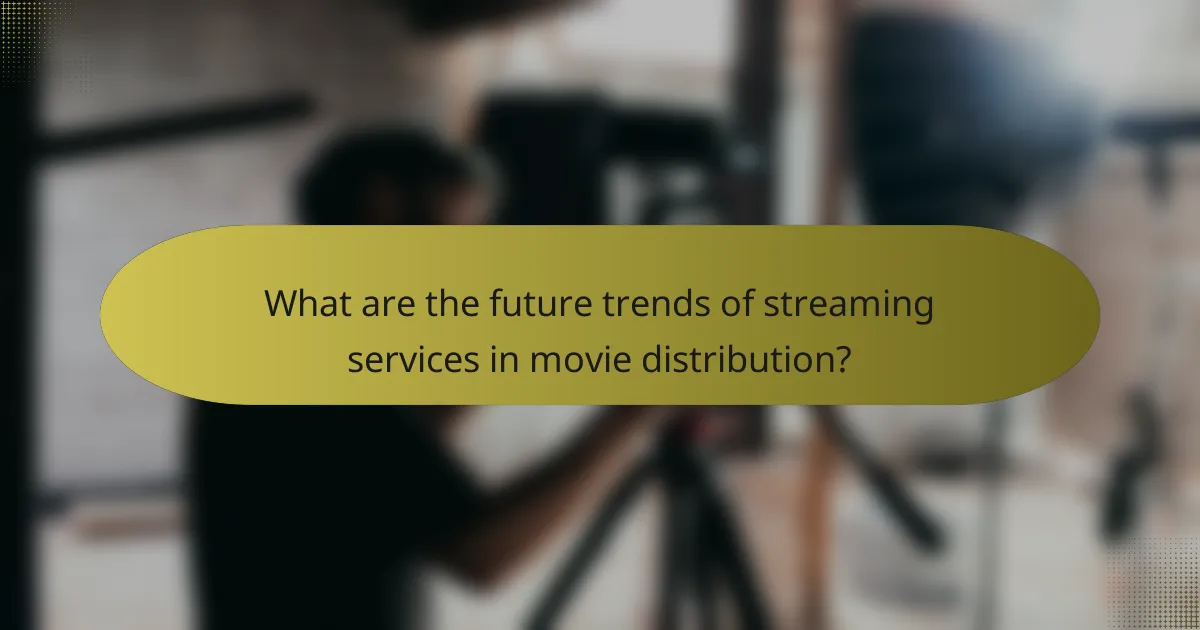Streaming services, such as Netflix and Amazon Prime Video, are fundamentally altering the movie distribution landscape by enabling filmmakers to bypass traditional theatrical releases and connect directly with consumers. This shift is projected to lead to over 1.5 billion streaming subscriptions by 2025, prompting studios to rethink budget allocations and marketing strategies. While streaming platforms prioritize original content and adapt to changing consumer preferences, they also face challenges like complex licensing agreements, intense competition, and technical issues affecting quality. Future trends indicate increased investment in exclusive films, personalized viewing experiences through advanced algorithms, and the rise of hybrid release models that combine theatrical and streaming options.

How are Streaming Services Impacting Movie Distribution?
Streaming services are significantly transforming movie distribution. They allow filmmakers to bypass traditional theatrical releases. This shift enables direct-to-consumer access, increasing audience reach. For instance, Netflix and Amazon Prime Video have released films simultaneously in theaters and online. A report by PwC indicates that streaming subscriptions are projected to exceed 1.5 billion by 2025. This growth influences how studios allocate budgets and marketing strategies. Additionally, streaming platforms often prioritize original content, reshaping production dynamics. The convenience of on-demand viewing alters audience consumption habits. Overall, streaming services are redefining the traditional movie distribution model.
What are the key features of streaming services?
Streaming services provide on-demand access to a wide variety of content. Key features include a vast library of movies and TV shows. Users can watch content anytime and anywhere with an internet connection. Many services offer original programming exclusive to their platform. Streaming quality often adapts based on user bandwidth, ensuring a smooth experience. Subscription models provide ad-free viewing options. Additionally, features like user profiles and personalized recommendations enhance user experience. Many platforms support multiple devices, allowing seamless transitions between screens.
How do streaming services differ from traditional movie distribution models?
Streaming services provide on-demand access to movies, unlike traditional distribution models that rely on theaters and physical media. Streaming services allow users to watch content anytime and anywhere with internet access. Traditional models typically require a scheduled release in theaters before home media availability. Streaming platforms often release entire seasons of shows at once, encouraging binge-watching. In contrast, traditional models usually follow a weekly episode release schedule. Streaming services often utilize subscription models, providing unlimited access for a monthly fee. Traditional models primarily rely on ticket sales and physical media purchases. The rise of streaming has significantly impacted box office revenues, with many consumers opting for home viewing instead of theater attendance. This shift has led to changes in how movies are produced, marketed, and consumed in the entertainment industry.
What technological advancements support streaming services?
Technological advancements that support streaming services include high-speed internet, cloud computing, and adaptive bitrate streaming. High-speed internet enables users to access content without buffering. According to the Federal Communications Commission, as of 2020, over 90% of Americans have access to broadband. Cloud computing allows for scalable storage and processing of vast libraries of content. This technology supports on-demand access to movies and shows. Adaptive bitrate streaming adjusts video quality based on the user’s internet speed. This ensures optimal viewing experiences across various devices. Furthermore, advancements in compression technologies reduce file sizes without sacrificing quality. These developments collectively enhance the efficiency and user experience of streaming services.
Why are streaming services becoming popular for movie distribution?
Streaming services are becoming popular for movie distribution due to their convenience and accessibility. Users can watch films anytime and anywhere with an internet connection. This flexibility allows for a more personalized viewing experience. Additionally, streaming services often provide a vast library of content. This extensive selection caters to diverse tastes and preferences. The subscription model also offers cost-effective options compared to traditional cinema. According to a 2021 report by Statista, over 80% of U.S. households use at least one streaming service. This widespread adoption demonstrates the shift in consumer behavior towards digital platforms for entertainment.
What consumer trends are driving the rise of streaming services?
The rise of streaming services is driven by consumer trends favoring convenience and personalization. Consumers prefer on-demand access to content without the constraints of traditional broadcasting schedules. The growth of mobile devices enhances accessibility to streaming platforms anytime and anywhere. Subscription-based models appeal to consumers seeking cost-effective entertainment options. Original content produced by streaming services attracts viewers looking for unique programming. Additionally, social media influences consumer choices, promoting trending shows and movies. Data from a 2023 report by Statista indicates that 82% of U.S. households subscribe to at least one streaming service. This reflects a significant shift in consumer preferences toward digital viewing experiences.
How do streaming services enhance viewer experience?
Streaming services enhance viewer experience by providing on-demand content access. Users can watch shows and movies anytime, anywhere. This flexibility caters to diverse schedules and preferences. Streaming platforms also offer personalized recommendations based on viewing habits. This feature helps viewers discover new content tailored to their interests. Additionally, many services provide high-definition video quality and surround sound options. These technical enhancements improve overall viewing enjoyment. Data from a 2021 study shows that 80% of users prefer streaming for its convenience and variety. Therefore, streaming services significantly transform how audiences engage with visual media.

What challenges do streaming services face in movie distribution?
Streaming services face several challenges in movie distribution. Licensing agreements can be complex and costly. They must negotiate rights with studios and filmmakers. Competition is fierce among platforms for exclusive content. This often drives up acquisition costs. Technical issues, such as bandwidth limitations, can affect streaming quality. Consumer preferences shift rapidly, requiring constant adaptation. Additionally, piracy remains a significant threat to revenue. These factors complicate the distribution landscape for streaming services.
How do licensing agreements affect streaming services?
Licensing agreements significantly influence streaming services by determining the content available for viewers. These agreements dictate which films and shows can be streamed on a platform. Streaming services negotiate with content creators and distributors to secure rights for specific titles. For example, Netflix and Hulu often compete for exclusive rights to popular series. The duration of these agreements can affect content availability over time. When a licensing agreement expires, the content may be removed from the service. This directly impacts user experience and subscription retention. Additionally, licensing costs can influence the pricing strategies of streaming services. According to a report by PwC, content acquisition is a major expense for streaming platforms.
What are the legal implications of streaming content?
Streaming content can lead to legal implications such as copyright infringement and licensing issues. Content creators retain rights to their works. Unauthorized streaming can violate these rights, resulting in lawsuits. Streaming services must obtain licenses to legally distribute content. Failure to do so can lead to financial penalties. The Digital Millennium Copyright Act (DMCA) provides a framework for addressing copyright issues online. It protects service providers from liability if they comply with takedown requests. Additionally, user-generated content platforms face unique challenges regarding copyright enforcement. Legal implications can vary by jurisdiction, affecting compliance and enforcement strategies.
How do geographical restrictions impact availability?
Geographical restrictions limit the availability of content on streaming services. These restrictions often arise due to licensing agreements and copyright laws. For example, a movie may be available in one country but not in another. This disparity can frustrate users who seek access to specific titles. Furthermore, geographical restrictions can lead to regional disparities in service quality and content variety. According to a 2021 study by the European Audiovisual Observatory, 40% of films are not available in multiple European countries due to such restrictions. This indicates a significant impact on the overall accessibility of streaming content.
What competition do streaming services encounter?
Streaming services encounter competition from traditional cable and satellite television providers. These providers offer bundled packages that include live TV and premium channels. Additionally, streaming services face rivalry from other streaming platforms, such as Hulu, Amazon Prime Video, and Disney+. These competitors often provide unique content and pricing strategies to attract subscribers. Furthermore, social media platforms like YouTube also compete for viewer attention with user-generated content. The rise of free ad-supported streaming services adds another layer of competition. According to a 2023 report by Statista, over 80% of U.S. households subscribe to at least one streaming service, highlighting the crowded market. As a result, streaming services must continually innovate to retain and grow their audience.
How do traditional studios respond to streaming services?
Traditional studios adapt to streaming services by developing their own platforms. They invest in original content to compete with established streaming giants. Many studios also enter partnerships with streaming services for distribution. This strategy allows them to reach wider audiences. Additionally, traditional studios are altering release strategies. They may choose simultaneous releases in theaters and on streaming platforms. This approach caters to changing viewer preferences. According to a 2021 report by PwC, 70% of consumers prefer streaming over traditional viewing methods. Such statistics highlight the urgency for studios to adapt.
What role do independent filmmakers play in the streaming landscape?
Independent filmmakers play a crucial role in the streaming landscape by diversifying content offerings. They provide unique narratives and perspectives often overlooked by major studios. Streaming platforms have become essential for these filmmakers to reach wider audiences.
In 2021, independent films made up approximately 25% of all films released on streaming services. This statistic highlights their significant presence in the digital space. Additionally, platforms like Netflix and Amazon Prime actively seek independent films to enhance their libraries.
This trend allows independent filmmakers to secure funding and distribution opportunities that were previously limited. The rise of streaming has democratized access to film distribution, enabling independent voices to thrive.

What are the future trends of streaming services in movie distribution?
Future trends of streaming services in movie distribution include increased investment in original content, personalization through advanced algorithms, and a shift towards hybrid release models. Streaming platforms are allocating larger budgets for exclusive films, aiming to attract subscribers. Personalized recommendations will enhance user engagement, utilizing data analytics to tailor viewing experiences. Additionally, hybrid models, combining theatrical releases with streaming availability, are becoming more common, as seen with major studios like Warner Bros. and Disney. These trends reflect the evolving consumer preferences for convenience and accessibility in film consumption.
How is content creation evolving with streaming services?
Content creation is evolving significantly with streaming services. Streaming platforms enable diverse content formats, including series, films, and documentaries. They allow for shorter episode lengths and varied storytelling styles. This flexibility caters to changing audience preferences for binge-watching and on-demand viewing. Data analytics from streaming services inform creators about viewer trends and preferences. This leads to more targeted and personalized content production. Major platforms invest heavily in original programming to attract subscribers. In 2022, Netflix spent approximately $17 billion on content creation. This investment drives competition and innovation in the industry.
What new genres or formats are emerging in streaming?
New genres and formats emerging in streaming include interactive storytelling and short-form content. Interactive storytelling allows viewers to make choices that influence the narrative. This format has gained popularity with series like “Bandersnatch” from Black Mirror. Short-form content, typically under 10 minutes, caters to audiences seeking quick entertainment. Platforms like Quibi previously focused on this format. Additionally, docuseries are blending documentary elements with episodic storytelling. This genre has seen success with series such as “Tiger King.” These emerging formats reflect changing viewer preferences and technological advancements in streaming.
How will viewer preferences shape future content offerings?
Viewer preferences will significantly shape future content offerings by influencing what types of films and series are produced. Streaming services analyze viewer data to identify trends and popular genres. For instance, the rise in demand for true crime documentaries has led to an increase in their production. According to a report by Deloitte, 70% of viewers prefer personalized content recommendations. This statistic underscores the importance of tailoring offerings to meet specific viewer interests. Additionally, streaming platforms are prioritizing diverse and inclusive content to cater to broader audiences. The success of shows like “Bridgerton” demonstrates how embracing viewer preferences can lead to increased viewer engagement and subscriptions. Ultimately, understanding viewer preferences will drive content strategies and investment decisions in the streaming industry.
What strategies can filmmakers adopt to succeed in the streaming era?
Filmmakers can succeed in the streaming era by focusing on unique storytelling and audience engagement. They should prioritize developing original content that stands out in a crowded market. Collaborating with streaming platforms for exclusive deals can increase visibility. Utilizing data analytics helps filmmakers understand viewer preferences and tailor content accordingly. Embracing innovative marketing strategies is essential to reach wider audiences. Building a strong online presence through social media enhances direct engagement with fans. Networking within the industry can lead to valuable partnerships and opportunities. Lastly, adapting to evolving technology, such as virtual reality, can offer new experiences for viewers.
How can filmmakers leverage data analytics for content creation?
Filmmakers can leverage data analytics for content creation by analyzing viewer preferences and trends. Data analytics provides insights into what genres, themes, and formats resonate with audiences. Filmmakers can use this information to tailor their scripts and marketing strategies. Streaming services like Netflix utilize viewer data to inform their original content decisions. According to a report by PwC, 57% of media executives believe data analytics significantly impacts content strategy. By understanding audience engagement metrics, filmmakers can enhance storytelling and character development. This approach increases the likelihood of a film’s success in a competitive market.
What marketing techniques are effective for promoting movies on streaming platforms?
Social media marketing is effective for promoting movies on streaming platforms. Engaging content on platforms like Instagram and Twitter can create buzz. Influencer partnerships can amplify reach and credibility. Targeted ads on social media platforms can attract specific audience segments. Email marketing campaigns can inform subscribers about new releases. Trailers and teasers shared online generate excitement. Collaborations with popular content creators can enhance visibility. Data analytics help refine marketing strategies based on audience engagement.
The main entity of the article is streaming services and their impact on movie distribution. The article explores how streaming platforms are transforming the traditional movie distribution model by enabling direct-to-consumer access, altering audience consumption habits, and influencing production dynamics. Key features of streaming services, such as on-demand access, original content, and personalized recommendations, are highlighted, along with the challenges they face, including licensing agreements and competition. Additionally, the article discusses future trends in content creation, viewer preferences, and strategies filmmakers can adopt to succeed in this evolving landscape.